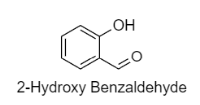
Write the structure of 2-hydroxybenzaldehyde.
Answer
496.8k+ views
1 likes
Hint: 2-hydroxybenzaldehyde is also known as Salicylic aldehyde has the chemical formula
Complete step by step answer: From the 2-hydroxybenzaldehyde name, we can get into conclusion that a hydroxyl group is situated to the benzaldehyde at second position.
The structure of 2-hydroxybenzaldehyde is:

The other common names for this compound is Salicylaldehyde or Salicylic aldehyde. The chemical formula of this structure is
Additional Information: Salicylaldehyde whose IUPAC name is 2-hydroxybenzaldehyde is an organic compound with wide applications. Along with 3-hydroxybenzaldehyde and 4-hydroxybenzaldehyde, it is one of the three isomers of hydroxybenzaldehyde. It is a colourless or pale-yellow liquid with a bitter almond odour and a burning taste. It is soluble in alcohol, benzene, and ether, and very slightly soluble in water. Salicylaldehyde is found in shrubs of the genus Spiraea and is usually produced from phenol by the action of chloroform in the presence of an alkali base. It is used in the production of coumarin, saligenin, and salicylaldoxime (an important analytical reagent), and also in analytical chemistry. For example, to detect hydrazine. Besides, salicylaldehyde is a key precursor to various chelating agents and a flavouring ingredient.
Note: 3-hydroxybenzaldehyde and 4-hydroxybenzaldehyde are also available which are position isomers of 2-hydroxybenzaldehyde.

Salicylaldehyde is synthesized from phenol, chloroform, and alkali according to the Reimer–Tiemman method, which was developed in 1876. The major uses of this chemical compound are perfumes, fumigants, flavour ingredients in foods, and medicinal chemicals.
Complete step by step answer: From the 2-hydroxybenzaldehyde name, we can get into conclusion that a hydroxyl group is situated to the benzaldehyde at second position.
The structure of 2-hydroxybenzaldehyde is:

The other common names for this compound is Salicylaldehyde or Salicylic aldehyde. The chemical formula of this structure is
Additional Information: Salicylaldehyde whose IUPAC name is 2-hydroxybenzaldehyde is an organic compound with wide applications. Along with 3-hydroxybenzaldehyde and 4-hydroxybenzaldehyde, it is one of the three isomers of hydroxybenzaldehyde. It is a colourless or pale-yellow liquid with a bitter almond odour and a burning taste. It is soluble in alcohol, benzene, and ether, and very slightly soluble in water. Salicylaldehyde is found in shrubs of the genus Spiraea and is usually produced from phenol by the action of chloroform in the presence of an alkali base. It is used in the production of coumarin, saligenin, and salicylaldoxime (an important analytical reagent), and also in analytical chemistry. For example, to detect hydrazine. Besides, salicylaldehyde is a key precursor to various chelating agents and a flavouring ingredient.
Note: 3-hydroxybenzaldehyde and 4-hydroxybenzaldehyde are also available which are position isomers of 2-hydroxybenzaldehyde.

Salicylaldehyde is synthesized from phenol, chloroform, and alkali according to the Reimer–Tiemman method, which was developed in 1876. The major uses of this chemical compound are perfumes, fumigants, flavour ingredients in foods, and medicinal chemicals.
Latest Vedantu courses for you
Grade 11 Science PCM | CBSE | SCHOOL | English
CBSE (2025-26)
School Full course for CBSE students
₹41,848 per year
Recently Updated Pages
Master Class 9 General Knowledge: Engaging Questions & Answers for Success

Master Class 9 English: Engaging Questions & Answers for Success

Master Class 9 Science: Engaging Questions & Answers for Success

Master Class 9 Social Science: Engaging Questions & Answers for Success

Master Class 9 Maths: Engaging Questions & Answers for Success

Class 9 Question and Answer - Your Ultimate Solutions Guide

Trending doubts
Give 10 examples of unisexual and bisexual flowers

Draw a labelled sketch of the human eye class 12 physics CBSE

Differentiate between homogeneous and heterogeneous class 12 chemistry CBSE

Differentiate between insitu conservation and exsitu class 12 biology CBSE

What are the major means of transport Explain each class 12 social science CBSE

Why is the cell called the structural and functional class 12 biology CBSE




